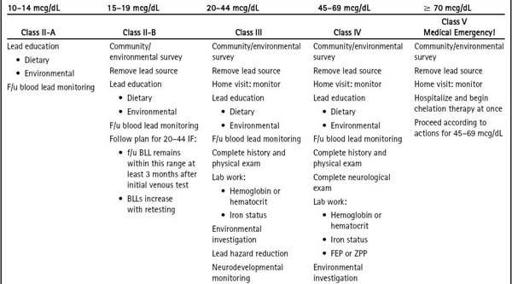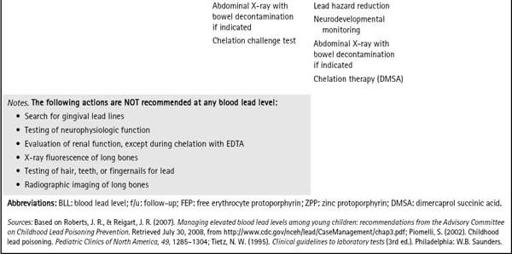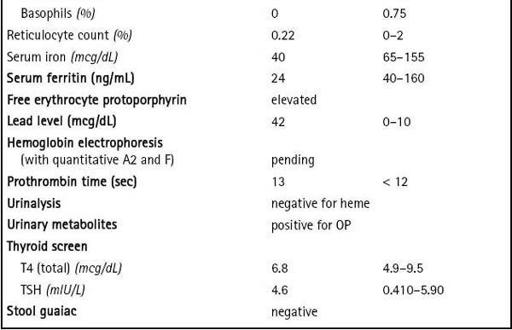Pediatric Primary Care Case Studies (77 page)
Read Pediatric Primary Care Case Studies Online
Authors: Catherine E. Burns,Beth Richardson,Cpnp Rn Dns Beth Richardson,Margaret Brady
Tags: #Medical, #Health Care Delivery, #Nursing, #Pediatric & Neonatal, #Pediatrics

Making the Diagnosis
Your diagnostic list now includes IDA, possible warfarin ingestion, and hypothyroidism as the most likely causes of Oswaldo’s signs and symptoms. The next phase in determining Oswaldo’s diagnosis and subsequent treatment is to perform laboratory diagnostic tests. For expediency and to minimize trauma to the toddler, several tests should be ordered simultaneously. Thus, you order the following tests:
• Complete blood count with white blood cell differential and peripheral blood smear (CBC with diff and PBS)
• Thyroid screen (T4, TSH, +/- T3)
• Lead level
• Prothrombin
• Urinary metabolites for organophosphates
• Stool guaiac
IDA: CBC with Differential
Specific tests to determine the type of anemia will be directed by the clinical presentation, history, and initial blood work. The causative factors of the anemia must be clarified. Information revealed in the complete blood count, peripheral blood smear, lead studies, thyroid studies, and hemoglobin electrophoresis would all help in refining the etiology of anemia. Findings in patient examination and history will further guide the diagnosis of anemia and the additional examinations needed to confirm the diagnosis. It is vital to remember that having the diagnosis of the type of anemia is not the end point. Bone marrow examination by itself is not a useful diagnostic tool in infants and toddlers because there is little or no iron stored in the marrow hemosiderin in these young children who do not have the marrow reserves that older children develop (Scott, 2006).
Warfarin Intoxication: Prothrombin Time
Serum measurements of warfarin are not readily available or useful in most ingestions because most labs are not able to provide timely reports of vitamin K–dependent clotting factors. Daily
prothrombin time (PT)
levels serve to quantify the anticoagulant effect of ingested rodenticide and to determine the necessary duration of vitamin K treatment. Some sources recommend repeating the PT test 24 and 48 hours post-ingestion (Olson et al., 2008). Mullins, Brands, and Daya’s (2000) study, however, suggests that in normal pediatric exposures to Super warfarin the PT test is not necessary and does not affect outcome. Normalization of the PT level within 48–72 hours indicates the quantity of warfarin ingested was insignificant.
Lead Intoxication: Lead Level
An elevated lead level is diagnostic of plumbism. The sample may be from either a capillary or venous source, but preparation of the site is vital to getting an accurate result. The skin must be well-cleaned to prevent contamination from surface lead dust. Capillary samples are much more sensitive to surface contamination due to the small size of the sample. If a capillary sample yields a lead level greater than 10 mcg/dL, a venous sample must be obtained to provide diagnostic confirmation. Levels less than 10 mcg/dL are considered normal.
Table 19-5
indicates the increments within elevated levels and how they are addressed therapeutically.
Hypothyroidism: Thyroxine and Thyroid Stimulating Hormone
A diagnosis of hypothyroidism would explain some but not all of Oswaldo’s symptoms. The tests used to determine thyroid status are the thyroxine (T4) and thyroid stimulating hormone (TSH) levels. Eighty percent of circulating thyroid hormone is T4 and the remaining 20% is T3, so determining the T4 level is usually adequate, but one can also include the T3 level for a complete thyroid picture. TSH levels reveal the functioning and role of the pituitary gland in directing thyroid function. A normal TSH level with a low T4 level indicates that the pituitary gland is not sensing or responding to the low circulating level of thyroid hormone. An elevated TSH level indicates that the pituitary gland has detected the low serum thyroid levels and has attempted to spur the thyroid gland to greater activity to compensate. When the TSH is high and the T4 is low, the implication is that the thyroid gland is malfunctioning (Kliegman et al., 2004).
You review the results of your laboratory studies, which are found in
Table 19-6
. Based upon these findings you identify the following diagnoses:
Interpretation of CBC with differential and PBS:
• Microcytic, hypochromic anemia
• RDW is increased, consistent with iron deficiency anemia
• Normal white blood cell count
• Reticulocyte is increased, as is normally seen in IDA
Interpretation of iron studies:
• Serum iron and serum ferritin are very low, indicating inadequate iron stores.
• The FEP is elevated, consistent with IDA and/or elevated lead level.
These results rule out thalassemia trait (diagnostic for thalassemia traits is microcytic anemia and normal FEP).
Lead level:
• A lead level of 42 constitutes a moderately high level, CDC classification III.
Table 19–5 Treatment Recommendations Based on Blood Lead Level


Table 19–6 Oswaldo’s Laboratory Results with Norms for Children 6 Months to 3 Years


Thyroid screening:
• T4 and TSH are both within normal range, indicating there is no hypothyroidism.
If hypothyroidism had been identified, primary treatment is by oral hormone replacement with levothyroxine. Because this medication can interact with many different drugs, it is important to review the child’s medication history at each visit. Families should be instructed to limit ingestion of goitrogenic foods (asparagus, cabbage, peas, turnip greens, broccoli, spinach, brussel sprouts, lettuce, and soybeans), plus soybean-based formulas, cottonseed meal, walnuts, and dietary fiber, because these may decrease absorption (Takemoto, Hodding, & Kraus, 2008). The dosage varies by age, decreasing as the child ages. Laboratory monitoring of serum levels consists of annual TSH levels. Treatment is best accomplished in consultation with or referral to a pediatric endocrinologist.
Prothrombin time:
• The PT is elevated, which is consistent with ingestion of Super warfarin.
Developmental testing:
• The results of Oswaldo’s developmental testing reveal he is delayed in gross and fine motor areas. There is a recommendation for close follow-up testing.
From these results, you arrive at your final list of diagnoses and determine their ICD codes.
Table 19-7
lists the ICD-9 codes based upon your final diagnoses. These diagnoses are:
• Moderate-severe iron deficiency anemia
• Lead poisoning, moderate
• Organophosphate exposure and warfarin ingestion
• Poor growth and delayed development
Management
There are general guidelines to consider when managing the diagnostic problems that Oswaldo has.
Table 19–7 ICD-9 Codes for Oswaldo’s Final Diagnoses | |
| Final Diagnosis | ICD-9 Code |
| Moderate-severe iron deficiency anemia | 280.9 |
| Lead poisoning, moderate | 984.9 |
| Organophosphate exposure | 989.3 |
| Warfarin ingestion (poison by agents affecting blood components) | 964 |
| Poor growth | 253.2 |
| Developmental delay | 783.5 |
Iron Deficiency Anemia
Iron supplementation is necessary with laboratory monitoring of the child’s response. Typically a trial of oral iron is started at 4 to 6 mg/kg/day of elemental iron in two to three divided doses per day. Reticulocytosis is typically seen after 4 days of therapy. Hemoglobin levels should be monitored. A return to normal Hgb level occurs within 4 to 6 weeks if iron supplementation is taken as prescribed. Because iron stores must be replenished, a course of iron supplementation is recommended for 2 to 3 months. Dietary counseling regarding iron-rich foods is an essential part of patient education. Blood monitoring of hemoglobin is typically done at 1 month. If there is an adequate response (an Hgb increase of at least 1 g/dL or a greater than 3% increase in hematocrit), the diagnosis of IDA is confirmed. A hemoglobin level is then drawn again approximately 6 months after iron supplementation is discontinued to confirm a full return to normal levels of Hgb (Schwartz, 2009).
Because Oswaldo does not simply have IDA but also has elevated lead levels and a hemoglobin of 7 gm/dL, you want to want to discuss his case with the hematologist.
Plumbism
The CDC committee developed guidelines to direct treatment of plumbism in primary care practices (see
Table 19-5
). The primary step in treatment is to remove the lead source from the child’s environment. Proper nutrition and the passage of time will generally serve to lower the levels of lead in mild to moderate intoxications. For symptomatic and severe intoxications by lead, it may be necessary to use chelation. Chelating agents are not without risks of their own and should be used by experienced healthcare providers in controlled situations.